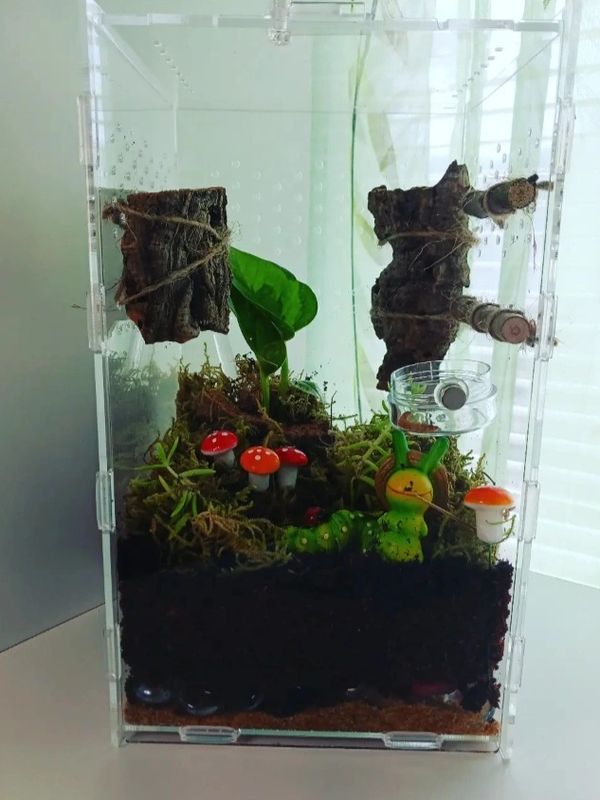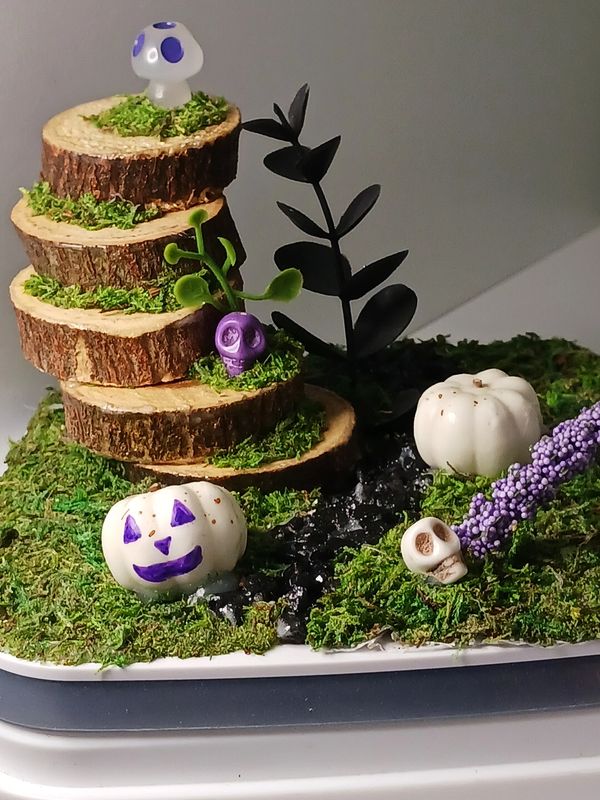We offer both custom made enclosures & bioactive setups for your pet spider































































Explore Different Types & Sizes of Jumping Spider Enclosures
Size Really Does Matter

In the wild jumpers may travel a far distance to find the perfect solitary space for them to lay down their webbing and create a hammock. Once they've created this safe space, which is usually pretty well hidden from the human eye and the eyes of predators, they stick to this area, and a very small surrounding space to hunt. At the end of their full day of basking in the sunlight, hunting down delicious bugs and exploring, they'll retreat to the same hammock night after night.
It's important to recreate the same safe space for them in captivity. They need to be able to bask, hunt and explore in an appropriate sized space that's suitable for them and makes them feel safe.
When exploring enclosures, remember your jumping spider's needs first. Large and lavishly decorated enclosures are amazing, but wouldn't be the ideal space for a sling to begin their worldly adventures. Ventilation holes are also extremely important to think about. If you're adopting a sling who still eats fruit flies, you need to be sure the ventilation will not allow for any escapees.
Also, it is important to note jumping spiders are arboreal and like to climb upward. Their living space should be taller, rather than wider.
What Size Enclsoure Is Best for Your Pet Jumping Spider?

Different species require different sized enclosures and different humidity levels. This information is helpful for Phidippus Regius, Phidippus Audax & Phidippus Otiosus.
When jumping spiders emerge from the egg sac they will hunt collectively until i4. At this age they become little cannibals and need their own space. 5oz deli cups, 3x3x3 OR 4x4x4 enclosures are a perfect size. Ventilation should be mesh, or Drilled holes smaller than a 1/16 drill bit. Jumping spiders can perfect their hunting skills and be successfully introduced and switch to larger prey in their sling, or small enclosures.
Once jumping spiders reach juvenile stage (i6/i7/i8) they can be housed in larger enclosures. 4x4x6 and 4x4x8 are great sizes. Keep in mind the size of the ventilation holes if your spider is still eating smaller prey like fruit flies.
Sub Adults and Adults should have enclosures that are at least 4x4x8 in size. Larger enclosures work well too, however 8x8x12 is plenty large. Anything larger may make hunting difficult and finding your jumping spider even harder.
Jumping Spider Enclosure Decor & Enrichment

Jumping Spiders need safe spaces to explore, jump and hide in their enclosures. You can choose to decorate your enclosure yourself, procure items to decorate, or even purchase an already made or custom decorated jumping spider Enclosure.
Clay, painted and natural wooden items should be sealed. We recommend using a dishwasher safe modge podge that can easily be found at your local craft store.
Items attached to the walls of the enclosure should be sturdy and unable to fall off when the enclosure is moved around. Gorilla Brand hot glue, E6000 and neodymium magnets are safe to use, but keep in mind curing times when using glues and make sure everything is securely attached before inviting your jumping spider in for a tour.
Natural items such as cork bark, wood & bamboo should be washed and baked at 175°f for an hour before being added to the enclosure. It is also recommended for these items to be sealed to prevent the growth of mold, but is not necessary.
Enrichment is anything your jumping spider can climb on, jump to or hide in. It's important to have different items in your enclosure that will allow for your jumping spider to explore and exercise. A good way to know if they need more enrichment is by looking at the web pattern they lay down. If it's sporadic and all over the place, that's excellent. If it's more repetitive around the inside perimeter of the enclosure, they may need more stimulation.
Hides are great places for your jumping spider to create hammocks, although they will literally create them wherever they like. Flowers, cork bark, bamboo, walnuts, 3D printed objects and even handmade creations make wonderful hides.
Ventilation, Humidity & Lighting

These are 3 main ingredients needed for jumping spider enclosures. Each one needs to be properly thought out to provide the perfect environment for your pet spider.
Humidity can be maintained by daily misting, using natural moss and substrate in your enclosure. It's important not to use dyed or preserved moss in an enclosure, or fertilized soil. If they get wet from misting, and your jumping spider drinks the water droplets from them, it may be toxic.
Cross ventilation, meaning ventilation on 2 opposite sides of the enclosure, is necessary. Ventilation size should be based off the size of your jumping spider and their prey. It should allow for your daily mists to remain on the enclosure walls for about 2 hours.
A hygrometer is a great way to tell if the humidity & temperature is correct inside of your jumping spider's enclosure. It should be about 60% humidity with an average temperature of 75°f. If your home is much cooler, 70°f or lower, a reptile heat mat with a thermostat can be used to help warm the enclosure. Keep it near, but not directly touching the enclosure, along one wall or side. Because our captive bred jumping spiders are native to Florida, a humidity of up to 75% is safe.
The proper amount of light is needed for your jumping spider to hunt and bask. Indirect sunlight and LED lighting is perfect. Never leave your spider in direct sunlight as the enclosure can overheat to dangerous temperatures. A cycle of 12 hours daylight and 12 hours of darkness is optimal. Opening the curtains during the day & using a timer for your LED lighting is a great way to make sure your jumping spiders get enough light each day.
Bottom Opening? Side Opening? Top Opening? Which design is best for jumping spiders?
Bottom Opening? Side Opening? Top Opening? Which design is best for jumping spiders?

Jumping Spiders are arboreal and naturally like to climb upwards. Most people believe jumping spiders will build their hammocks at the highest point in their enclosure, making top opening enclosures unpopular for some keepers.
This is not entirely true as jumping spiders will create their hammocks where they feel safe and comfortable. The picture above is a Bioactive enclosure our family created for our Sub Adult Phidippus Regius, Lilly. She has created both of her hammocks behind the cork bark strategically placed lower in her top opening enclosure. The top opening makes it easy to care for the plants, feed and allows her an easy opening to come out for some playful interaction.
Bottom opening make for great decorated and custom enclosures. The top portion will need to be placed upside down or on it's side from time to time, so it's very important that all items are secure inside. Cork feeding holes are a game changer and very convenient for bottom opening enclosures.
Side opening enclosures, depending on where they open, may be disruptive to a hammock, or make it difficult to reach items inside. Proper planning can help out a lot with this and make a front opening enclosure work well for you and your jumping spider. Using an enclosure that also opens from the top or strategically placing hides along the back wall can work wonders for a front opening enclosure.
In the end, it's whatever works best for you, the set up and your pet jumping spider.
Bioactive Setups
Bottom Opening? Side Opening? Top Opening? Which design is best for jumping spiders?

Decorated and custom enclosures are uniquely beautiful and can be made to replicate anything, really. Bioactive setups are just as fun and unique as they are constantly growing and evolving.
The substrate usually consists of a drainage layer of rocks and/or sand, coco fiber or top soil, moss and a cleanup crew of isopods and springtails.
A wide variety of plants such as tropical varieties, pothos, succulents and air plants can be used to create a lush and visually appealing environment with lots of enrichment for your jumping spider. It's important that they have not been near any pesticides for the safety of your jumping spider.
Hides, corkbark, ledges, and clay figures make for great additions to any bioactive enclosure. A must have is a feeding dish so no wiggly feeders burrow in the substrate.
The all natural elements are wonderful for keeping a healthy humidity and providing your jumping spider with an amazing habitat that's similar to their native environment.
How To Properly Clean Your Jumping Spider Enclosure & Accessories
How To Properly Clean Your Jumping Spider Enclosure & Accessories
How To Properly Clean Your Jumping Spider Enclosure & Accessories

Jumping spiders work extremely hard building meticulous hammocks and laying down webbing. This is their way of making home...home 🏠. We suggest leaving all webbing and hammocks in tact. You can use feeding tongs or tweezers to gently remove any left over prey or debris from the webbing if needed.
Enclosure walls, decor and flooring can become soiled with spider poop and bug guts. Improper ventilation and unsealed wood can grow mold. Dawn dish soap and white vinegar are great and safe for cleaning and disinfecting. Mix a couple of drops of dish soap & a tablespoon of vinegar in a small bowl of hot water. Use a soft bristle toothbrush to scrub the surfaces clean. Rinse thoroughly with water and dry with a soft cloth or paper towel. If rinsed properly, the enclosure should not smell of soap or vinegar.
